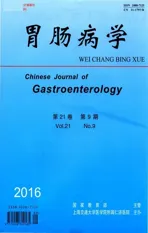功能性消化不良不同亚型患者心理因素的比较研究
2016-11-14贺国斌
张 琴 贺国斌 刘 平 向 佳 向 霞
宣汉县人民医院消化内科1(636150) 川北医学院附属医院消化内科2
·短篇论著·
功能性消化不良不同亚型患者心理因素的比较研究
张 琴1贺国斌2*刘 平1向 佳1向 霞1
宣汉县人民医院消化内科1(636150) 川北医学院附属医院消化内科2
背景:焦虑、抑郁、躯体化是影响功能性消化不良(FD)患者生活质量的重要因素,但与FD各亚型之间的关系尚不完全清楚。目的:探索焦虑、抑郁和躯体化对FD各亚型患者的影响。方法:应用焦虑自评量表(GAD-7)、抑郁自评量表(PHQ-9)、躯体化症状自评量表(PHQ-15)、悉尼消化不良指数简表(NDI)和消化不良症状严重度量表(DSS)分别评估223例FD患者的焦虑、抑郁、躯体化、生活质量和消化不良严重度,并分析焦虑、抑郁、躯体化对FD各亚型生活质量和消化不良的影响。结果:EPS、PDS和EPS与PDS重叠组的GAD-7、PHQ-9、PHQ-15、NDI、DSS评分相比差异有统计学意义(P<0.05)。FD各亚型患者的生活质量与焦虑、抑郁和躯体化均相关(P<0.05),而消化不良严重度仅与躯体化相关(P<0.05)。抑郁和躯体化是影响FD各亚型患者生活质量的因素(P<0.05),躯体化是影响各亚型患者消化不良的因素(P<0.05)。结论:EPS与PDS症状重叠患者的焦虑、抑郁、躯体化较EPS、PDS患者严重,对生活质量和消化不良的影响亦更大。
功能性消化不良; 焦虑; 抑郁; 躯体化
功能性消化不良(FD)是最常见的功能性胃肠疾病,分为上腹痛综合征(epigastric pain syndrome, EPS)、餐后不适综合征(postprandial distress syndrome, PDS)[1]。FD可能的病理生理机制包括胃感觉运动功能障碍、幽门螺杆菌(Hp)感染、精神心理因素等[2-3],且精神心理因素和躯体化为影响FD患者生活质量和症状严重度的重要因素[4],但与FD各亚型之间的关系仍存在争议。瑞典的一项研究[5]表明焦虑而非抑郁与PDS相关,与EPS无关;台湾的一项研究[6]表明精神心理应激特别是抑郁、躯体化、恐惧与PDS相关,与EPS无关;而Fischler等[7]的研究表明精神心理因素和躯体化与EPS相关。本研究通过研究焦虑、抑郁、躯体化等危险因素与FD各亚型之间的关系,旨在为今后进一步指导FD不同亚型患者的临床治疗提供一定的依据。
对象与方法
一、一般资料
选取2014年1月—2015年6月宣汉县人民医院消化内科门诊符合罗马Ⅲ标准[1]的拟诊断FD患者264例。纳入标准:①年龄18~65岁;②性别不限;③排除器质性疾病。排除标准:①胃镜检查发现存在器质性病变如消化性溃疡、肿瘤、出血、食管炎或血管病变等;②同时合并有糖尿病、恶性肿瘤、严重肝肾功能疾病;③有甲状腺疾病、精神病史、腹部手术史;④有腹痛伴排便频率与性状改变等肠易激综合征为主要表现者;⑤最近2周内服用过抗胆碱药、解痉药、阿司匹林以及其他非甾体消炎药;⑥年龄<18岁。因FD患者常合并焦虑或抑郁且两者相互影响[2,4],故本研究未排除伴有焦虑或抑郁的患者。入选者均签署知情同意书。
二、研究方法
应用广泛性焦虑障碍量表(GAD-7)[8]、患者健康问卷抑郁症状群量表(PHQ-9)[9]、患者健康问卷躯体化症状群量表(PHQ-15)[10]、悉尼消化不良指数简表(NDI)[11]、消化不良症状严重度量表(DSS)[12]分别对FD患者焦虑、抑郁、躯体化、生活质量和消化不良严重度进行评估。
三、统计学分析
结 果
一、一般情况
共223例FD患者入选,其中男63例,女160例;年龄18~65岁,平均(43.4±9.0)岁;病程6~360个月,中位病程24个月(8~60个月);EPS患者69例,PDS患者44例,EPS与PDS重叠者110例。
二、FD不同亚型患者评分结果
不同亚型FD患者的性别构成和年龄相比差异无统计学意义(P>0.05),而焦虑、抑郁、躯体化、生活质量和消化不良评分相比差异有统计学意义(P<0.05)(表1)。
三、相关性分析结果
不同FD亚型患者的生活质量与焦虑、抑郁和躯体化均相关(P<0.05)。
EPS患者消化不良与躯体化相关(P<0.05),PDS患者消化不良与抑郁和躯体化相关(P<0.05),EPS与PDS重叠患者消化不良与焦虑、抑郁、躯体化均相关(P<0.05)。
四、回归分析结果
抑郁和躯体化是影响FD患者生活质量的因素(P<0.05),而非焦虑。躯体化是影响FD患者消化不良严重度的因素(P<0.05),而非焦虑和抑郁。
讨 论
根据罗马Ⅲ标准FD分为以上腹部疼痛或烧灼感为主要特征的EPS和以餐后饱胀或早饱为主要特征的PDS,但这种分类标准是基于罗马Ⅱ标准的流行病学和病理生理机制的研究结果,缺乏直接的科学证据[1,13]。FD的治疗策略包括检测和根除Hp、应用PPI以及促胃肠动力药物、抗抑郁药物,但这些治疗策略仅对部分患者有效[13]。了解精神心理因素和躯体化对FD不同亚型患者的影响,有益于提高治疗疗效。
本研究中,EPS、PDS以及症状重叠患者的焦虑、抑郁、躯体化、生活质量和消化不良评分相比差异均有统计学意义(P<0.05),且症状重叠患者的评分高于EPS和PDS患者;相关性分析结果显示躯体化对FD患者生活质量和消化不良的影响较焦虑、抑郁更大,且抑郁对生活质量和消化不良的影响大于焦虑,而焦虑、抑郁、躯体化对症状重叠患者生活质量、消化不良的影响程度强于EPS和PDS患者;回归分析结果显示抑郁和躯体化是影响不同亚型患者生活质量的因素,躯体化是影响不同亚型患者症状严重度的因素。
本研究所纳入的患者均来自三级医院,其中49.3%的患者为EPS与PDS症状重叠患者。Vakil等[14]的研究中症状重叠患者所占的比例为66%。以人群为基础的研究中,FD患者更易于区分为EPS和PDS,而以医院为基础的研究中,存在明显的EPS与PDS重叠患者[13],表明症状重叠患者的病情可能更严重。本研究亦发现症状重叠患者与抑郁的相关性最强,与Clauwaert等[15]和Fang等[16]的研究结果相似。病理生理的研究表明PDS患者较EPS患者存在更普遍的胃容受性受损[13],与抑郁相关的自主功能障碍可能会损伤胃的容受性从而导致PDS[17],推测PDS患者应用抗抑郁药物的效果更佳。躯体化和抑郁是影响各亚型FD患者生活质量和消化不良症状严重度的因素,与Van Oudenhove等[2,4]和Jones等[18]的研究结果相一致。然而,症状重叠患者的焦虑、抑郁、躯体化较EPS、PDS更严重的病因仍尚不清楚,需在今后的病因学研究中进一步探索。

表1 FD各亚型的人口统计学特征以及焦虑、抑郁、躯体化、生活质量和消化不良评分
*与EPS组比较,P﹤0.001;与EPS与PDS重叠组比较,#P﹤0.05,△P﹤0.01
综上所述,EPS与PDS症状重叠患者的焦虑、抑郁、躯体化较EPS、PDS患者严重,对生活质量和消化不良的影响亦更大,有助于今后指导不同亚型FD患者的治疗,但仍需进一步研究证实。
1 Tack J, Talley NJ, Camilleri M, et al. Functional gastroduodenal disorders[J]. Gastroenterology, 2006, 130 (5): 1466-1479.
2 Van Oudenhove L, Vandenberghe J, Geeraerts B, et al. Determinants of symptoms in functional dyspepsia: gastric sensorimotor function, psychosocial factors or somatisation? [J]. Gut, 2008, 57 (12): 1666-1673.
3 Moayyedi P, Deeks J, Talley NJ, et al. An update of the Cochrane systematic review ofHelicobacterpylorieradication therapy in nonulcer dyspepsia: resolving the discrepancy between systematic reviews[J]. Am J Gastroenterol, 2003, 98 (12): 2621-2626.
4 Van Oudenhove L, Vandenberghe J, Vos R, et al. Risk factors for impaired health-related quality of life in functional dyspepsia[J]. Aliment Pharmacol Ther, 2011, 33 (2): 261-274.
5 Aro P, Talley NJ, Ronkainen J, et al. Anxiety is associated with uninvestigated and functional dyspepsia (Rome Ⅲ criteria) in a Swedish population-based study[J]. Gastroenterology, 2009, 137 (1): 94-100.
6 Hsu YC, Liou JM, Liao SC, et al. Psychopathology and personality trait in subgroups of functional dyspepsia based on Rome Ⅲ criteria[J]. Am J Gastroenterol, 2009, 104 (10): 2534-2542.
7 Fischler B, Tack J, De Gucht V, et al. Heterogeneity of symptom pattern, psychosocial factors, and pathophys-iological mechanisms in severe functional dyspepsia[J]. Gastroenterology, 2003, 124 (4): 903-910.
8 Spitzer RL, Kroenke K, Williams JB, et al. A brief measure for assessing generalized anxiety disorder: the GAD-7[J]. Arch Intern Med, 2006, 166 (10): 1092-1097.
9 Kroenke K, Spitzer RL, Williams JB. The PHQ-9: validity of a brief depression severity measure[J]. J Gen Intern Med, 2001, 16 (9): 606-613.
10 Kroenke K, Spitzer RL, Williams JB. The PHQ-15: validity of a new measure for evaluating the severity of somatic symptoms[J]. Psychosom Med, 2002, 64 (2): 258-266.
11 Talley NJ, Verlinden M, Jones M. Quality of life in functional dyspepsia: responsiveness of the Nepean Dyspepsia Index and development of a new 10-item short form[J]. Aliment Pharmacol Ther, 2001, 15 (2): 207-216.
12 Kindt S, Van Oudenhove L, Mispelon L, et al. Longitudinal and cross-sectional factors associated with long-term clinical course in functional dyspepsia: a 5-year follow-up study[J]. Am J Gastroenterol, 2011, 106 (2): 340-348.
13 Tack J, Talley NJ. Functional dyspepsia--symptoms, definitions and validity of the Rome Ⅲ criteria[J]. Nat Rev Gastroenterol Hepatol, 2013, 10 (3): 134-141.
14 Vakil N, Halling K, Ohlsson L, et al. Symptom overlap between postprandial distress and epigastric pain syndromes of the Rome Ⅲ dyspepsia classification[J]. Am J Gastroenterol, 2013, 108 (5): 767-774.
15 Clauwaert N, Jones MP, Holvoet L, et al. Associations between gastric sensorimotor function, depression, somatization, and symptom-based subgroups in functional gastroduodenal disorders: are all symptoms equal? [J]. Neurogastroenterol Motil, 2012, 24 (12): 1088-e565.
16 Fang YJ, Liou JM, Chen CC, et al; Taiwan Gastrointestinal Disease and Helicobacter Consortium. Distinct aetiopathogenesis in subgroups of functional dyspepsia according to the Rome Ⅲ criteria[J]. Gut, 2015, 64 (10): 1517-1528.
17 Carney RM, Freedland KE, Veith RC. Depression, the autonomic nervous system, and coronary heart disease[J]. Psychosom Med, 2005, 67 Suppl 1: S29-S33.
18 Jones MP, Coppens E, Vos R, et al. A multidimensional model of psychobiological interactions in functional dyspepsia: a structural equation modelling approach[J]. Gut, 2013, 62 (11): 1573-1580.
(2015-11-03收稿;2016-01-01修回)
Comparative Study on Psychological Factors in Subgroups of Patients with Functional Dyspepsia
ZHANGQin1,HEGuobin2,LIUPing1,XIANGJia1,XIANGXia1.
1DepartmentofGastroenterology,People’sHospitalofXuanhanCounty,Dazhou,SichuanProvince(636150);2DepartmentofGastroenterology,theAffiliatedHospitalofNorthSichuanMedicalCollege,Nanchong,SichuanProvince
HE Guobin, Email: heguob@163.com
Functional Dyspepsia; Depression; Anxiety; Somatization
10.3969/j.issn.1008-7125.2016.09.010
*本文通信作者,Email: heguob@163.com
Background: Anxiety, depression and somatization are important influencing factors of quality of life in patients with functional dyspepsia (FD), but the relationship with subgroups of FD remains not fully clear. Aims: To explore the influence of anxiety, depression and somatization on subgroups of FD patients. Methods: Generalized Anxiety Disorder-7 (GAD-7), Patient Health Questionnaire-9 (PHQ-9), Patient Health Questionnaire-15 (PHQ-15), Nepean Dyspepsia Index (NDI) and Dyspepsia Symptoms Score (DSS) were used to evaluate anxiety, depression, somatization, quality of life and dyspepsia of 223 FD patients, respectively. The influences of anxiety, depression and somatization on quality of life and dyspepsia in subgroups of FD were analyzed. Results: Significant differences in score of GAD-7, PHQ-9, PHQ-15, NDI, DSS were found among EPS group, PDS group and EPS-PDS overlapping group (P<0.05). Quality of life in subgroups of FD was correlated with anxiety, depression and somatization (P<0.05), and dyspepsia was correlated with somatization (P<0.05). Depression and somatization were the determinants of quality of life in subgroups of FD patients (P<0.05), and somatization was the determinant of dyspepsia in subgroups of FD patients (P<0.05). Conclusions: Anxiety, depression and somatization in EPS-PDS overlapping patients are more severe than those in EPS and PDS patients, and the influence of these three risk factors on quality of life and dyspepsia are more severe.
